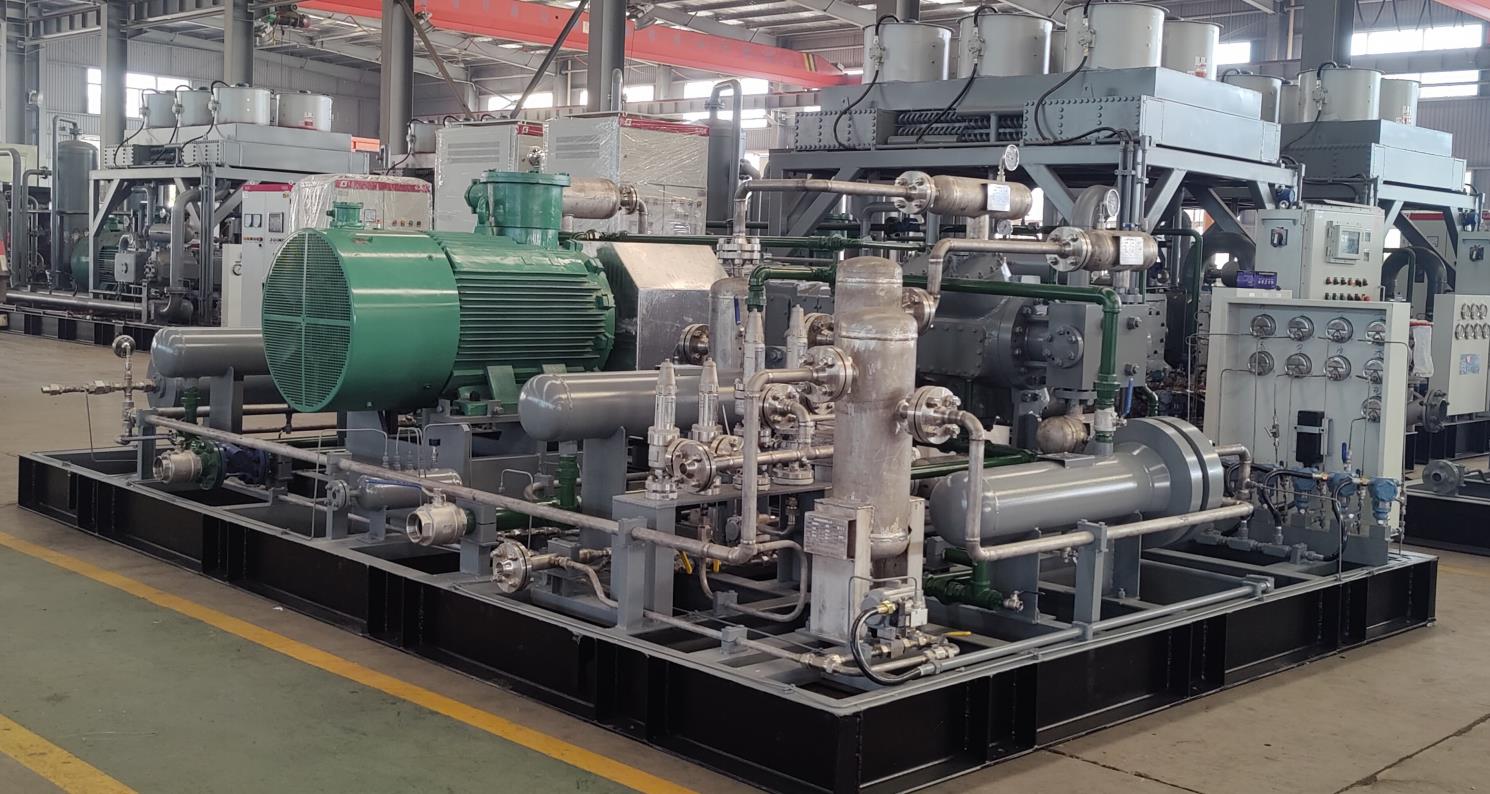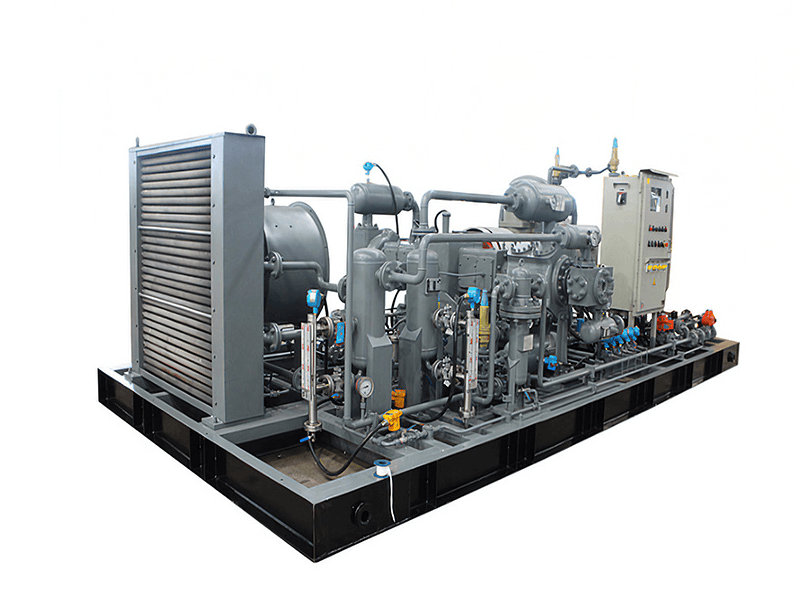Chlorine gas compressors are critical equipment used in industries such as chemical manufacturing, water treatment, and chlor-alkali production. While specific faults can vary depending on the compressor design and operating conditions, here are some common faults that can occur:
1. Leakage: Compressors can experience leakage in various areas, such as seals, valves, fittings, or piping connections. Chlorine gas is highly corrosive, and even small leaks can be hazardous. It is crucial to regularly inspect and maintain seals and connections to prevent leaks.
2. Corrosion: Chlorine gas is highly corrosive to many materials, including metals. Corrosion can occur on the compressor housing, valves, cylinders, and other components exposed to chlorine gas. Regular inspection, appropriate material selection, and protective coatings can help mitigate corrosion-related issues.
3. Contamination: Chlorine gas compressor may experience contamination from impurities or foreign particles present in the gas. This can lead to fouling of valves, clogging of filters, and reduced efficiency of the compressor. Proper filtration and maintenance practices are essential to minimize contamination-related problems.
4. Valve Problems: Valves in chlorine compressor can face issues such as valve seat erosion, valve sticking, or improper sealing. These problems can result in reduced compressor efficiency, increased energy consumption, and decreased overall performance. Regular inspection, cleaning, and maintenance of valves are necessary to prevent and address these issues.
5. Overheating: Inadequate cooling or excessive heat generation can cause the compressor to overheat. Factors such as insufficient lubrication, improper ventilation, or high ambient temperatures can contribute to overheating problems. Monitoring temperature levels, ensuring proper lubrication, and maintaining adequate ventilation are crucial for preventing overheating.
6. Mechanical Failures: Mechanical failures can occur in various components, such as bearings, pistons, rods, and crankshafts. These failures can result from factors like excessive vibration, inadequate lubrication, or fatigue over time. Regular inspection, lubrication, and adherence to maintenance schedules can help detect and address potential mechanical issues.
7. Electrical Faults: Electrical faults can affect the motor or control systems of the compressor, leading to malfunctions, motor failures, or safety hazards. Regular inspection of electrical connections, wiring, and control systems, along with preventive maintenance practices, can help identify and rectify electrical faults.
8. Vibration and Noise: Excessive vibration and abnormal noise levels can indicate underlying issues with the compressor, such as misalignment, worn-out components, or imbalanced rotating parts. Monitoring vibration and addressing any abnormalities promptly can help prevent further damage and ensure smooth operation.

9. Pressure Irregularities: Fluctuations in discharge pressure or failure to maintain the desired pressure can be indicative of problems with valves, seals, or piston rings. These issues can lead to inefficient compression, reduced system performance, or even complete compressor failure. Regular inspection and maintenance of these components are necessary to maintain consistent pressure.
10. Motor or Drive System Problems: The compressor's motor or drive system can experience faults such as motor overheating, electrical failures, or issues with the motor drive mechanism. These problems can affect the compressor's performance, efficiency, and reliability. Regular inspection, motor maintenance, and electrical system checks can help identify and address these faults.
11. Lubrication Issues: Insufficient or improper lubrication can result in increased friction, wear, and potential damage to compressor components. Lubrication systems should be properly maintained, and lubricants should be regularly checked and replaced as per manufacturer recommendations.
12. Control System Malfunctions: The control system of a chlorine gas compressor regulates various parameters such as pressure, temperature, and flow. Malfunctions in the control system can lead to incorrect operation, safety hazards, or inadequate compressor performance. Regular calibration, monitoring, and maintenance of the control system are necessary to ensure accurate and reliable operation.
Fault handling
When troubleshooting faults in chlorine gas compressors, it's important to prioritize safety and follow proper procedures. Here are some general troubleshooting methods that can help identify and address common issues:
1. Gather Information: Begin by gathering relevant information about the compressor, such as its specifications, operating conditions, maintenance records, and any recent changes or incidents. This can provide valuable insights into potential causes of the fault.
2. Visual Inspection: Conduct a thorough visual inspection of the compressor and its components. Look for signs of leaks, corrosion, loose connections, damaged parts, or any other visible abnormalities. Pay attention to areas exposed to chlorine gas, such as valves, seals, and piping.
3. Check Instrumentation and Controls: Verify the accuracy and functionality of pressure gauges, temperature sensors, flow meters, and other instrumentation. Ensure they are correctly calibrated and functioning properly. Check control settings and compare them to recommended operating parameters.
4. Review Operating Conditions: Review the operating conditions of the compressor, including suction and discharge pressure, temperature, and flow rates. Compare them to the recommended ranges specified by the compressor manufacturer. Deviations from the normal operating conditions can indicate issues.
5. Monitor Performance: Monitor the performance of the compressor, including energy consumption, vibration levels, noise, and any unusual behavior. Compare the current performance to historical data or baseline values to identify deviations.
6. Conduct Tests: Perform specific tests to diagnose the fault further. For example, conduct a leak test to identify and locate any leaks in the system. Use appropriate testing equipment and follow safety procedures.
7. Analyze Fluids and Lubricants: Analyze the fluids and lubricants used in the compressor. Check for contamination, degradation, or abnormal levels of impurities. This can help identify potential issues related to fluid quality or lubrication.
8. Consult Manuals and Documentation: Refer to the compressor's operation and maintenance manuals, technical documentation, and troubleshooting guides provided by the manufacturer. Follow the recommended troubleshooting steps specific to the compressor model.
9. Seek Expert Assistance: If the fault is complex or beyond your expertise, it is advisable to seek assistance from qualified compressor technicians or professionals. They can provide specialized knowledge and experience to diagnose and resolve the issue safely and effectively.
Remember to always prioritize safety during troubleshooting activities. Follow proper safety procedures, wear appropriate protective equipment, and consult with experts when needed.


























